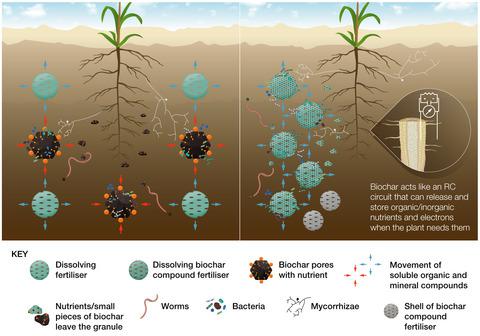当前位置:
X-MOL 学术
›
GCB Bioenergy
›
论文详情
Our official English website, www.x-mol.net, welcomes your
feedback! (Note: you will need to create a separate account there.)
How biochar works, and when it doesn't: A review of mechanisms controlling soil and plant responses to biochar
Global Change Biology Bioenergy ( IF 5.9 ) Pub Date : 2021-07-27 , DOI: 10.1111/gcbb.12885 Stephen Joseph 1, 2 , Annette L. Cowie 3 , Lukas Van Zwieten 4, 5 , Nanthi Bolan 5, 6 , Alice Budai 7 , Wolfram Buss 8 , Maria Luz Cayuela 9 , Ellen R. Graber 10 , Jim Ippolito 11 , Yakov Kuzyakov 12, 13 , Yu Luo 14 , Yong Sik Ok 15 , Kumuduni Niroshika Palansooriya 15 , Jessica Shepherd 16 , Scott Stephens 17 , Zhe (Han) Weng 18, 19 , Johannes Lehmann 20
Global Change Biology Bioenergy ( IF 5.9 ) Pub Date : 2021-07-27 , DOI: 10.1111/gcbb.12885 Stephen Joseph 1, 2 , Annette L. Cowie 3 , Lukas Van Zwieten 4, 5 , Nanthi Bolan 5, 6 , Alice Budai 7 , Wolfram Buss 8 , Maria Luz Cayuela 9 , Ellen R. Graber 10 , Jim Ippolito 11 , Yakov Kuzyakov 12, 13 , Yu Luo 14 , Yong Sik Ok 15 , Kumuduni Niroshika Palansooriya 15 , Jessica Shepherd 16 , Scott Stephens 17 , Zhe (Han) Weng 18, 19 , Johannes Lehmann 20
Affiliation

|
We synthesized 20 years of research to explain the interrelated processes that determine soil and plant responses to biochar. The properties of biochar and its effects within agricultural ecosystems largely depend on feedstock and pyrolysis conditions. We describe three stages of reactions of biochar in soil: dissolution (1–3 weeks); reactive surface development (1–6 months); and aging (beyond 6 months). As biochar ages, it is incorporated into soil aggregates, protecting the biochar carbon and promoting the stabilization of rhizodeposits and microbial products. Biochar carbon persists in soil for hundreds to thousands of years. By increasing pH, porosity, and water availability, biochars can create favorable conditions for root development and microbial functions. Biochars can catalyze biotic and abiotic reactions, particularly in the rhizosphere, that increase nutrient supply and uptake by plants, reduce phytotoxins, stimulate plant development, and increase resilience to disease and environmental stressors. Meta-analyses found that, on average, biochars increase P availability by a factor of 4.6; decrease plant tissue concentration of heavy metals by 17%–39%; build soil organic carbon through negative priming by 3.8% (range −21% to +20%); and reduce non-CO2 greenhouse gas emissions from soil by 12%–50%. Meta-analyses show average crop yield increases of 10%–42% with biochar addition, with greatest increases in low-nutrient P-sorbing acidic soils (common in the tropics), and in sandy soils in drylands due to increase in nutrient retention and water holding capacity. Studies report a wide range of plant responses to biochars due to the diversity of biochars and contexts in which biochars have been applied. Crop yields increase strongly if site-specific soil constraints and nutrient and water limitations are mitigated by appropriate biochar formulations. Biochars can be tailored to address site constraints through feedstock selection, by modifying pyrolysis conditions, through pre- or post-production treatments, or co-application with organic or mineral fertilizers. We demonstrate how, when used wisely, biochar mitigates climate change and supports food security and the circular economy.
中文翻译:

biochar 如何工作,何时不工作:控制土壤和植物对 biochar 反应的机制综述
我们综合了 20 年的研究来解释确定土壤和植物对生物炭反应的相关过程。生物炭的特性及其在农业生态系统中的影响在很大程度上取决于原料和热解条件。我们描述了生物炭在土壤中的三个反应阶段:溶解(1-3 周);反应性表面开发(1-6 个月);和老化(超过 6 个月)。随着生物炭老化,它被纳入土壤团聚体中,保护生物炭碳并促进根系沉积物和微生物产物的稳定。生物炭碳在土壤中存在数百至数千年。通过提高 pH 值、孔隙率和可用水量,生物炭可以为根系发育和微生物功能创造有利条件。生物炭可以催化生物和非生物反应,特别是在根际,增加植物的养分供应和吸收,减少植物毒素,刺激植物发育,并提高对疾病和环境压力的抵御能力。荟萃分析发现,平均而言,生物炭可将磷的可用性提高 4.6 倍;重金属的植物组织浓度降低17%~39%;通过负启动增加土壤有机碳 3.8%(范围 -21% 至 +20%);并减少非 CO2土壤温室气体排放量减少 12%–50%。荟萃分析显示,添加生物炭后平均作物产量增加了 10%–42%,低营养吸磷酸性土壤(热带地区常见)和旱地沙质土壤增加最大,因为养分保留和持水能力。由于生物炭的多样性和生物炭的应用环境,研究报告了植物对生物炭的广泛反应。如果通过适当的生物炭配方减轻特定地点的土壤限制以及养分和水分限制,作物产量会大幅增加。生物炭可以通过原料选择、改变热解条件、生产前或生产后处理或与有机或矿物肥料共同施用来定制,以解决场地限制。我们展示了如何在明智地使用时,
更新日期:2021-07-27
中文翻译:

biochar 如何工作,何时不工作:控制土壤和植物对 biochar 反应的机制综述
我们综合了 20 年的研究来解释确定土壤和植物对生物炭反应的相关过程。生物炭的特性及其在农业生态系统中的影响在很大程度上取决于原料和热解条件。我们描述了生物炭在土壤中的三个反应阶段:溶解(1-3 周);反应性表面开发(1-6 个月);和老化(超过 6 个月)。随着生物炭老化,它被纳入土壤团聚体中,保护生物炭碳并促进根系沉积物和微生物产物的稳定。生物炭碳在土壤中存在数百至数千年。通过提高 pH 值、孔隙率和可用水量,生物炭可以为根系发育和微生物功能创造有利条件。生物炭可以催化生物和非生物反应,特别是在根际,增加植物的养分供应和吸收,减少植物毒素,刺激植物发育,并提高对疾病和环境压力的抵御能力。荟萃分析发现,平均而言,生物炭可将磷的可用性提高 4.6 倍;重金属的植物组织浓度降低17%~39%;通过负启动增加土壤有机碳 3.8%(范围 -21% 至 +20%);并减少非 CO2土壤温室气体排放量减少 12%–50%。荟萃分析显示,添加生物炭后平均作物产量增加了 10%–42%,低营养吸磷酸性土壤(热带地区常见)和旱地沙质土壤增加最大,因为养分保留和持水能力。由于生物炭的多样性和生物炭的应用环境,研究报告了植物对生物炭的广泛反应。如果通过适当的生物炭配方减轻特定地点的土壤限制以及养分和水分限制,作物产量会大幅增加。生物炭可以通过原料选择、改变热解条件、生产前或生产后处理或与有机或矿物肥料共同施用来定制,以解决场地限制。我们展示了如何在明智地使用时,


















































 京公网安备 11010802027423号
京公网安备 11010802027423号